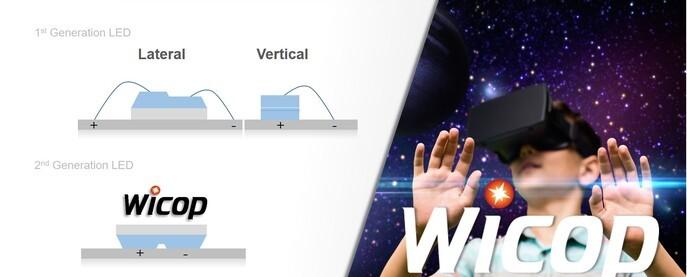When the concept of "meta-universe" swept the world, the investment scale and market size of AR/VR/MR headset devices, smart glasses and other markets continued to challenge new levels, including display technology. From materials, chips, drives, packaging, displays to terminal applications, players have increased, financing, investment continues, and related products are also accelerating their influx to the market in the second half of the year.
According to LEDinside incomplete statistics, foreign brands, Vuzix, WaveOptics, etc. have released Micro LED AR smart glasses commercial products and sample machines; domestic brands, Xiaomi, TCL's Thunderbird, OPPO, etc. have also developed Micro LED smart glasses, of which OPPO's Micro LED AR glasses have been mass-produced.
As more brands launch terminal application products, the display industry chain is becoming more and more active, such as the chip side. Nanjing Xinshiyuan released the first MICRO LED self-developed chip for AR/VR and launched the B+ round of strategic financing to strengthen the layout of the track; HC Semitek's current Mini/Micro LED chips have been used for AR/VR equipment... Recently, another company announced that it will soon launch Micro LED display products for VR.
Seoul Vios entered the market, and Micro LED products for VR will be launched
Today, Viosch Seoul announced that it will launch its first WICOP mc (WICOP Micro Pixel) product for microdisplays in metacosmos VR headsets at CES on January 5, 2022.

WICOP mc (WICOP Micro Pixel)
According to reports, WICOP mc using Seoul Semiconductor's WICOP patent technology, which is a lead-free bonding, no packaging LED technology, at present, its Mini/Micro LED and automotive LED products are based on WICOP technology development. Seoul Vios believes that WICOP technology can meet the needs of Mini/Micro LED production below 100μm.
Seoul Vios said that the company has now successfully developed LED technology for VR, which will be shown separately to VIP customers who have booked. At CES 2022, Viosch Seoul will also feature an 82-inch FHD monitor with 6.2 million WICOP mc chips and a 40-inch display with 2.8 million chips.
Micro LED technical problems continue to break through, AR/VR equipment mass production is in sight
Seoul Viosy pointed out that AR/VR has attracted much attention, but because high-performance displays that meet the display needs of AR/VR devices have not yet been developed, such devices have not yet been used in daily life.
Compared with LCD/OLED technology, Micro LED technology has obvious advantages in high brightness, high resolution, low power consumption, design flexibility and other performance, so it is widely favored in the field of AR/VR equipment. However, LCD/OLED technology has achieved large-scale mass production, and Micro LED is still facing many problems that hinder mass production, such as the efficiency of Micro LED will decline with the reduction of chip size.
For this problem, many companies and research units around the world have been seeking breakthroughs, including Seoul Wei Aoshi. The company is committed to improving the level of efficiency under micro LED microforming and helping to solve the problem of mass production of Micro LED, and this year made a breakthrough.
It is understood that Seoul Vios and the University of California, Santa Barbara, UCSB) in the field of Micro LED technology continue to maintain close cooperation, the two sides have been smaller than 5 micron Micro LED outside the quantum efficiency change trend of research, the study found that InGaN-based red Micro LED has the opportunity to help create a smaller size of the full-color Micro LED display.
In August this year, Seoul Viosch announced that it had jointly developed a blue Micro LED chip and a green LED with a size of less than 1 μm in conjunction with the SSLEEC team in Santa Barbara, led by UCSB physics expert Shuji Nakamura, and successfully increased the outer quantum efficiency of the 70 μm red Micro LED chip by 150%, significantly increasing the brightness of the Micro LED.
In this regard, Seoul Viosy said that it successfully broke through the problem of outer quantum efficiency and began mass production of products using 70μm red micro LED chips. On this basis, Seoul Viosex estimates that all Micro LED display applications will soon be commercialized, such as consumer electronics such as smartphones and AR/VR.
According to its announced plans, 30μm single-pixel Micro LED will be launched in the second half of this year, and 10μm single-pixel Micro LED products will be launched in 2022, although there is no further news at present. However, with the arrival of cess in January, more details of the performance of Micro LED products for Viosch VR in Seoul may be revealed.
According to the current official news, WICOP mc solves the problem of LED efficiency decline, can achieve 2000 PPI high-resolution VR display, to meet all the requirements of micro-display technology.
For Seoul Vios, technological breakthroughs and the advent of new products mean that investment will accelerate monetization. It is understood that the sales volume of Mini/Micro LED products of Seoul Wei aoshi has risen for three consecutive quarters this year, especially Micro LED, and related products have continued to achieve significant growth since the beginning of this year, becoming an important driving force for its steady growth in performance, and future growth is more promising.
For the Micro LED industry, this is also good news. At the same time, its partner UCSB has recently made new breakthroughs in the study of InGaN-based LEDs. In addition, foreign Micro LED-related technology providers Porotech, Soitec, King Abdullah University of Science and Technology (KAUST) team and domestic gable optoelectronics have promoted the process of Micro LED mass production to a certain extent, and also indicate that AR/VR Micro LED technology is constantly breaking through the bottleneck problem and gradually approaching the end of commercial mass production. (Text: LEDinside Janice)
Please indicate the source of the reprint! For more LED information, please pay attention to the official website or search for the WeChat public account (LEDinside).